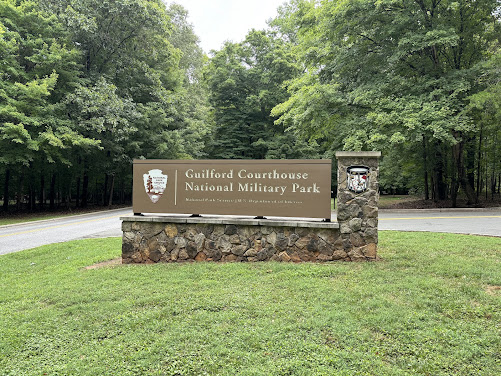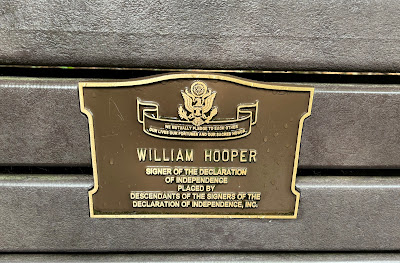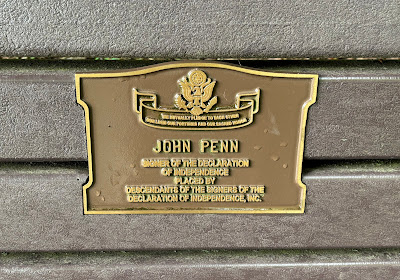It's amazing the places we've visited as we try to see the signers of the Declaration of Independence. Case in point - Guilford Courthouse in Greensboro, North Carolina.
The First Maryland Regiment
Charging the British Guards
Painted by Frank E. Buffmire from illustration by F.C. Yohn
There was a small Visitor Center.
Many beautiful paintings to see.
John Penn (1740-1788)
Signer of the Declaration of Independence from North Carolina
William Hooper (1742-1790)
Signer of the Declaration of Independence from North Carolina
And some interesting artifacts.
After the Revolution Hooper returned to his career in law, but he lost favor with the public because of his political stance. He was again called to public service in 1786, when he was appointed a federal judge in a border dispute between New York and Massachusetts, though the case was settled out of court. In 1787 and 1788, Hooper campaigned heavily for North Carolina to ratify the new United States Constitution, but by this time he had become quite ill and died in 1790.
He was laid to rest in the the Presbyterian Churchyard in Hillsborough, North Carolina and his remains were reinterred at Guilford Courthouse National Military Park in 1894. Many historians believe that much of his remains are still in the original grave.
John Penn (1741-1788) was an American Founding Father who served multiple terms in the Continental Congress and who signed both the Declaration of Independence and Articles of Confederation as a delegate of North Carolina.
In 1780, Penn left Congress to return to his law practice at home in Stovall, North Carolina where he died in 1788. He was originally buried at his homesite, but was re-interred at Guilford National Military Park in 1894.
Starting in 1887, the Guilford Battleground Company began commemorating the battle to bring awareness to this pivotal conflict. The Company felt that the best way to commemorate and bring awareness to the battlefield, the encounter itself, and the American Revolution was to place a variety of monuments and re-inter graves of key historical figures to the Revolutionary War. The key monument was the General Greene Monument, dedicated on July 3, 1915.
The fighting did not go according to plan for either side. After an orderly retreat, Greene expressed disappointment in the results of the battle. As reports trickled in, however, it became clear that the British army had suffered severed casualties. Cornwallis and his weakened army retired to the North Carolina coast.
After resigning his commission and facing a large amount of debt, Greene relocated to the South to focus on the slave plantations he had been awarded during the war. He made his home at the Mulberry Grove Plantation outside of Savannah. In 1784, Greene declined appointment to a commission tasked with negotiating treaties with Native Americans, but he agreed to attend the first meeting of the Society of the Cincinnati. He then became an original member with the Rhode Island Society of the Cincinnati.
Greene fell ill and died at Mulberry Grove on June 19, 1786, at the age of 43. The official cause of death was sunstroke. For over a century, his remains were interred at the Graham Vault in Colonial Park Cemetery in Savannah alongside John Maitland, his arch-rival. In 1902, his remains were moved to a monument in Johnson Square in Savannah.
Photo taken in Savannah, 2022
Back to Guilford Courthouse and the base of the memorial.
We stopped at a few of the monuments on Monument Row.
Jethro Exum Sumner (c. 1733-c. 1785)
Jethro Sumner was a senior officer of the Continental Army during the Revolutionary War. After the conclusion of the French and Indian War, Sumner moved to Bute County, North Carolina, where he acquired a substantial area of land and operated a tavern.
Sumner was named the commanding officer of the 3rd North Carolina Regiment of the North Carolina Line, a formation of the Continental Army in 1776, and served in both the Southern theater and Philadelphia campaign. He was one of the five brigadier generals from North Carolina in the Continental Army, in which capacity he served between 1779 and 1783.
James Gillies was a bugler for Richard Henry (Light Horse Harry) Lee, and as a musician had risen from a private to the commissioned officer rank of cornet at the time of his death. Cornet was likely a brevet rank awarded to those who performed the signal function that officers used to redirect their troops with drums, fifes, and bugles. His exact age is unknown but during the Revolutionary War it was not uncommon to enlist boys, some as young as 11-13 years old. His commander Light Horse Harry Lee, in his memoirs described him as "that beardless youth" and he had already been in Lee's region for almost three years. In a footnote, Lee expressed that "this ill-fated boy was one of the band of music, and exclusively devoted in the field to his bugle used in conveying orders."
On February 12, 1781, Gillies accompanied a small posse of Revolutionaries from a camp near present-day Summerfield (Guilford County) to verify reports of nearby Loyalists to the west. They were spotted, chased, and Gillies was caught and killed by the sword during the retreat to warn Lee of the advancement. He is buried in the Charles Bruce family cemetery in Summerfield.
The monument below states:
On this spot
Brig. Gen Edward Stevens
Was wounded while making a gallant stand with his Virginia troops
From Guilford Courthouse we moved on to Wake Forest University in Winston-Salem, North Carolina.
Reynolda Hall
North Campus consists of Hearn Plaza, better known as "the quad", which holds six upperclassmen residential buildings, a Subway restaurant, a book/office supply store, a clothing/athletic store, and Wait Chapel.
Hearn Plaza
Clothing/athletic store
Of course we went inside to check out the clothing store.
Hats!
While we didn't make it to the South Campus, as we walked back to the parking lot we saw some more of the university.
What a beautiful campus. And with that, our quick stop in North Carolina came to an end.





























No comments:
Post a Comment